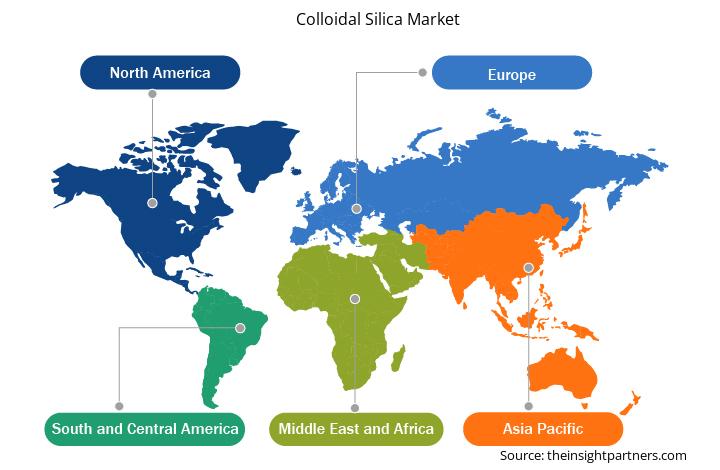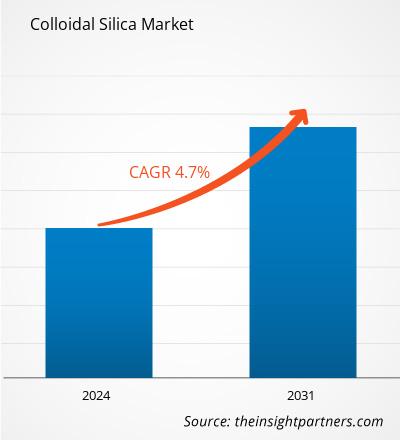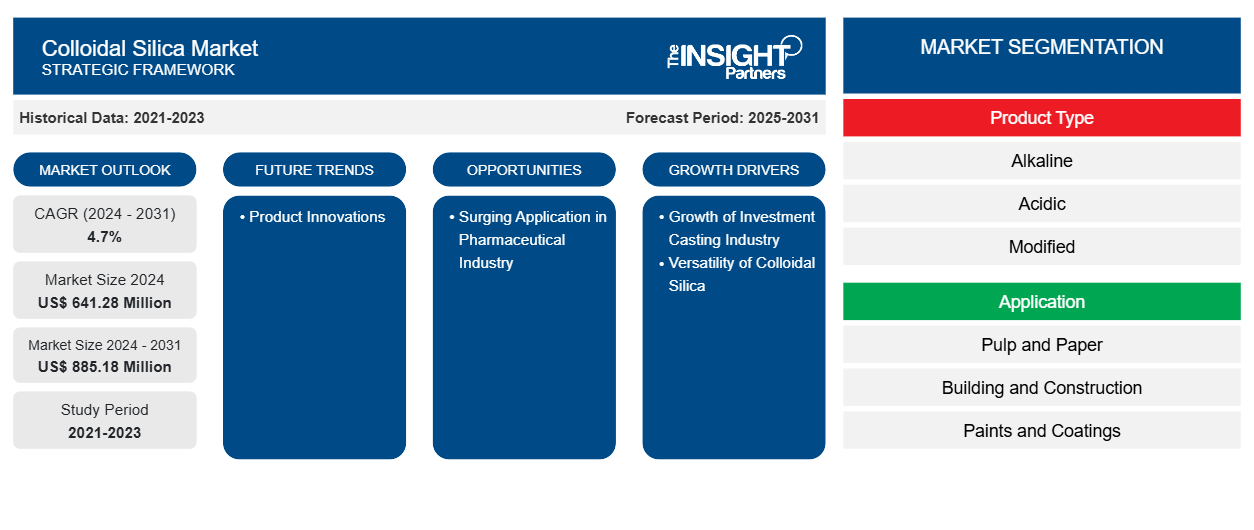胶体二氧化硅市场规模预计将从 2024 年的 6.4128 亿美元增至 2031 年的 8.8518 亿美元;预计 2024-2031 年期间市场复合年增长率为 4.7%。新产品创新有望为市场带来新趋势。
胶体二氧化硅市场分析
熔模铸造(也称为失蜡铸造或精密铸造)是最古老的金属成型工艺之一。它已被用于制造复杂的铸件、近净形状和不同的材料。在此过程中,蜡模用于塑造一次性陶瓷模具。蜡模的形状与要铸造的物体的精确形状相匹配,并涂有耐火陶瓷材料。胶体二氧化硅是精密熔模铸造行业中常用的粘合剂,因为它是一种安全、经济、易于使用的浆料成分,可作为主要或备用浆料。这种形式的二氧化硅非常稳定,由于粘合剂的化学惰性,可与各种耐火材料形成长寿命的陶瓷浆料。由于该领域的不断创新,新型熔模铸造应用的开发推动了胶体二氧化硅市场的进步。
胶体二氧化硅市场概览
胶体二氧化硅市场正在经历显着增长,这得益于其在各个行业的广泛应用。胶体二氧化硅是一种悬浮在液体中的二氧化硅细颗粒,由于其高纯度、分散性和稳定性等独特性能,广泛应用于汽车、电子、化学品和化妆品等领域。在汽车行业,胶体二氧化硅是制造高性能油漆、涂料和粘合剂的必需品,而在电子行业,它用于半导体和微电子制造。对先进技术和高性能材料的需求不断增长,再加上胶体二氧化硅在水处理和催化剂载体中的应用日益增多,进一步推动了市场扩张。
定制此报告以满足您的需求
您可以免费定制任何报告,包括本报告的部分内容、国家级分析、Excel 数据包,以及为初创企业和大学提供优惠和折扣
-
获取此报告的关键市场趋势。这个免费样品将包括数据分析,从市场趋势到估计和预测。
胶体二氧化硅市场驱动因素和机遇
胶体二氧化硅的多功能性促进了市场的增长
从增强氧气阻隔性能到提高油墨吸收率,胶体二氧化硅在制造过程中发挥着不同的作用。它是一种用途广泛的材料,可以改善建筑、食品和饮料等行业中使用的许多产品的性能。此外,胶体二氧化硅还广泛用于电子工业,作为抛光剂,在半导体晶圆中产生清洁的表面。它通过氢键和离子键能很好地粘附在许多表面上,促进表面改性应用。一旦涂在表面上,二氧化硅颗粒就会增加摩擦系数,这对工业和建筑涂料、抛光浆、地板以及纸张和纸板非常有用。这些键具有化学惰性和热稳定性,使其特别适用于绝缘板、催化剂、特种涂料、真空成型耐火材料和熔模铸造浆料。
粒径较大的胶体二氧化硅等级作为表面改性剂更有效,而粒径较小的胶体二氧化硅等级作为粘合剂效果更佳。其他因素(如最终配方的离子特性和 pH 值)有助于确定胶体二氧化硅所需的特性。因此,胶体二氧化硅的多功能性确保了各种最终用途行业对这种材料的持续需求,从而推动了市场增长。
制药行业应用激增创造增长机会
胶体二氧化硅是药物配方中的一种多功能赋形剂,在增强产品稳定性、改善流动性和控制释放曲线方面发挥着至关重要的作用。慢性病患病率的上升,加上全球人口老龄化,推动了全球制药业的增长。可支配收入的增加和政府政策也推动了这些行业的增长。根据汇丰银行的数据,“健康中国2030”计划旨在到2030年将国家医疗服务业的规模扩大到约2.4万亿美元。此外,由于私人和公共医疗支出增加、制药制造和服务能力蓬勃发展以及医疗技术生态系统不断发展,印度的医疗保健市场正在蓬勃发展,该国已成为新的医疗保健中心。
随着制药行业努力创新和开发新的药物输送系统,未来几年对胶体二氧化硅的需求也将继续增加。药物输送技术的显著进步,包括控释制剂和靶向药物输送系统,通常需要针对特定特性定制的赋形剂。胶体二氧化硅的独特特性——特别是高表面积和可控的粒度——使其成为这些先进药物输送系统的理想选择。因此,对医疗药丸的不断增长的需求加上政府为公共卫生采取的各种举措,正在支持胶体二氧化硅市场的增长。
胶体二氧化硅市场报告细分分析
有助于得出胶体二氧化硅市场分析的关键部分是产品类型和应用。
- 根据产品类型,胶体二氧化硅市场分为碱性、酸性、改性和普通。
- 根据应用,市场细分为纸浆和造纸、建筑和施工、油漆和涂料、电子和半导体、制药、熔模铸造、化妆品、家用产品等。油漆和涂料细分市场进一步细分为金属涂料、陶瓷涂料等。
胶体二氧化硅市场份额按地区分析
胶体二氧化硅市场报告的地理范围主要分为五个区域:北美、亚太、欧洲、中东和非洲、南美和中美。
预计亚太地区将在预测期内占据市场主导地位。亚太地区是全球主要的半导体制造中心。随着对消费电子产品的持续需求,亚太地区的半导体行业继续蓬勃发展。该地区的几个国家是全球半导体行业的主要推动者;例如,按收入计算,台湾是全球第二大芯片经济体。此外,尽管该行业有所放缓,但预计汽车应用将推动亚太地区半导体行业的资本支出。对半导体的需求持续增长;与 COVID-19 危机期间制造业暂停形成鲜明对比的是,2020 年需求激增,导致半导体短缺。因此,为了清理积压订单,该地区的许多制造商计划扩大生产水平,这预计将使胶体二氧化硅市场受益。
胶体二氧化硅 (硅溶胶) 还用于纺织、造纸、涂料、耐火材料、陶瓷和铸造等行业。汽车行业极大地推动了亚太地区的胶体二氧化硅市场。随着该地区汽车产量和销量的持续激增,对汽车零部件的需求也在增加。根据 OICA 的数据,亚洲-大洋洲的汽车产量从 2022 年的 5000 万辆增加到 2023 年的 5510 万辆。因此,该地区电动汽车的快速普及推动了对高性能汽车零部件的需求,从而推动市场走向增长。
胶体二氧化硅市场区域洞察
Insight Partners 的分析师已详细解释了预测期内影响胶体二氧化硅市场的区域趋势和因素。本节还讨论了北美、欧洲、亚太地区、中东和非洲以及南美和中美洲的胶体二氧化硅市场细分和地理位置。

- 获取胶体二氧化硅市场的区域具体数据
胶体二氧化硅市场报告范围
| 报告属性 | 细节 |
|---|---|
| 2024 年的市场规模 | 6.4128亿美元 |
| 2031 年市场规模 | 8.8518亿美元 |
| 全球复合年增长率(2024 - 2031) | 4.7% |
| 史料 | 2021-2023 |
| 预测期 | 2025-2031 |
| 涵盖的领域 |
按产品类型
|
| 覆盖地区和国家 |
北美
|
| 市场领导者和主要公司简介 |
|
胶体二氧化硅市场参与者密度:了解其对业务动态的影响
胶体二氧化硅市场正在快速增长,这得益于终端用户需求的不断增长,而这些需求又源于消费者偏好的不断变化、技术进步以及对产品优势的认识不断提高等因素。随着需求的增加,企业正在扩大其产品范围,进行创新以满足消费者的需求,并利用新兴趋势,从而进一步推动市场增长。
市场参与者密度是指在特定市场或行业内运营的企业或公司的分布情况。它表明在给定市场空间中,相对于其规模或总市场价值,有多少竞争对手(市场参与者)存在。
在胶体二氧化硅市场运营的主要公司有:
- 卡博特公司
- 赢创工业集团
- 默克公司
- 艺康公司
- 诺力昂化学控股有限公司
- WR Grace & Co
免责声明:上面列出的公司没有按照任何特定顺序排列。

- 了解胶体二氧化硅市场的主要参与者概况
胶体二氧化硅市场新闻和最新发展
通过收集来自一手和二手研究的定性和定量数据来评估胶体二氧化硅市场,其中包括重要的公司出版物、协会数据和数据库。以下列出了市场的一些发展情况:
- Evonik Industries AG 在其位于密歇根州韦斯顿的新工厂开始为半导体行业生产超高纯度胶体二氧化硅。新工厂是 Evonik 产品组合的战略补充,也是其致力于为半导体市场的客户提供创新和供应保障的证明。(Evonik,公司网站,2024 年)
- Nouryon Chemicals Holding BV 位于美国威斯康星州格林贝的制造工厂的 Levasil 胶体二氧化硅产品生产能力已扩大近 50%。通过此次扩大,该公司满足了对胶体二氧化硅日益增长的需求,尤其是在北美,这在战略上有助于其扩大全球胶体二氧化硅制造足迹,以服务于区域和国际客户。(Nouryon Chemicals Holding BV,公司网站,2024 年)
- Evonik Industries AG 在美国密歇根州韦斯顿的工厂建造了一家新工厂,生产超高纯度胶体二氧化硅。凭借这家新工厂,该公司有望成为市场上唯一能够可靠地生产化学机械平面化 (CMP) 所需的胶体二氧化硅的公司之一,CMP 是微芯片生产中的一项工艺步骤,具有必要的质量和纯度。(Evonik,公司网站,2023 年)
- AMS 应用材料解决方案宣布了一项多方面的计划,到 2030 年扩大其在新加坡的业务。该计划旨在加强公司的全球制造和研发能力,拓宽新加坡的技术生态系统合作伙伴关系,并促进当地劳动力发展。(AMS 应用材料解决方案,公司网站,2022 年)
胶体二氧化硅市场报告范围和交付成果
“胶体二氧化硅市场规模和预测(2021-2031)”报告对以下领域进行了详细的市场分析:
- 胶体二氧化硅市场规模及范围内所有主要细分市场的预测
- 胶体二氧化硅市场趋势,以及市场动态,如驱动因素、限制因素和关键机遇
- 详细的波特五力分析和 SWOT 分析
- 胶体二氧化硅市场分析涵盖主要市场趋势、国家框架、主要参与者、法规和最新的市场发展。
- 行业格局和竞争分析,涵盖市场集中度、热点图分析、知名参与者以及市场最新发展
- 详细的公司简介
- 历史分析(2 年)、基准年、预测(7 年)及复合年增长率
- PEST和SWOT分析
- 市场规模、价值/数量 - 全球、区域、国家
- 行业和竞争格局
- Excel 数据集
近期报告
客户评价
购买理由
- 明智的决策
- 了解市场动态
- 竞争分析
- 客户洞察
- 市场预测
- 风险规避
- 战略规划
- 投资论证
- 识别新兴市场
- 优化营销策略
- 提升运营效率
- 顺应监管趋势























 获取免费样品 - 胶体二氧化硅市场
获取免费样品 - 胶体二氧化硅市场